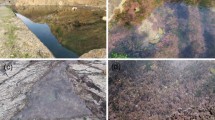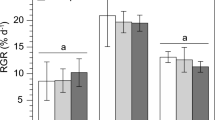Abstract
In order to study the ecophysiological response of a natural diatom-dominated microbial mat to an enhanced level of ultraviolet-B radiation (UVBR), intact sediment cores from a shallow microtidal bay on the Swedish west coast were incubated in an outdoor flow-through system and exposed to either no UVBR or to an artificially enhanced level of UVBR. The microbial mat was cohesive and dominated by the large (≈ 400 μm) motile diatom Gyrosigma balticum. Functional response to UVBR was assessed by measuring carbon fixation (14C) and allocation of photosynthetic products. Sediment oxygen microprofiles were measured as indicators of the balance between the photosynthetic and respiratory activity of the community. Structural variables included biomass and composition of microalgae, pigment composition (HPLC), content of UV-absorbing compounds, and composition of fatty acids. An enhanced level of UVBR resulted in significant functional changes in the microalgal community. Significantly decreased carbon fixation and lower net oxygen production (as calculated from oxygen microprofiles) suggest that primary productivity in the type of microbial mat studied is potentially sensitive to an enhanced level of UVBR. The pattern of carbon allocation hinted a change as to the photosynthetically active part of the community when exposed to UVBR, indicating a differential sensitivity among algal cells. Despite significant functional effects, pigment or algal composition were not significantly affected by enhanced UVBR. The concentration of UV-absorbing compounds was low and did not increase at UVBR exposure. Due to the short duration of the experiment (4 d), a change in algal biomass or composition was not to be expected. Moreover, the thickness of the sampled sediment layer, may have contributed to the lack of observed structural effects of enhanced UVBR. Visual observations suggested that UVBR affected the motility of G. balticum. This study, as well as other experiments with a similar diatom mat, suggest that vertical migration is a key mechanism to be further studied in relation to UVBR exposure of diatom-dominated microbial mats.
Similar content being viewed by others
Author information
Authors and Affiliations
Additional information
Received: 7 September 1996 / Accepted: 8 October 1996
Rights and permissions
About this article
Cite this article
Sundbäck, K., Odmark, S., Wulff, A. et al. Effects of enhanced UVB radiation on a marine benthic diatom mat. Marine Biology 128, 171–179 (1997). https://doi.org/10.1007/s002270050080
Issue Date:
DOI: https://doi.org/10.1007/s002270050080




